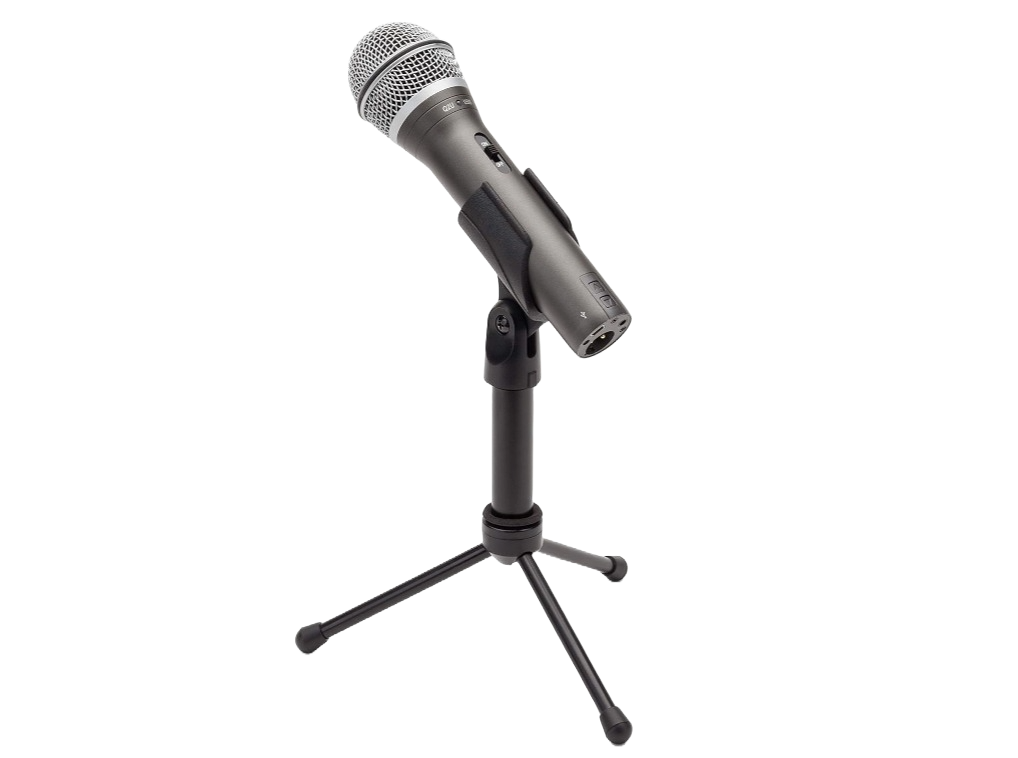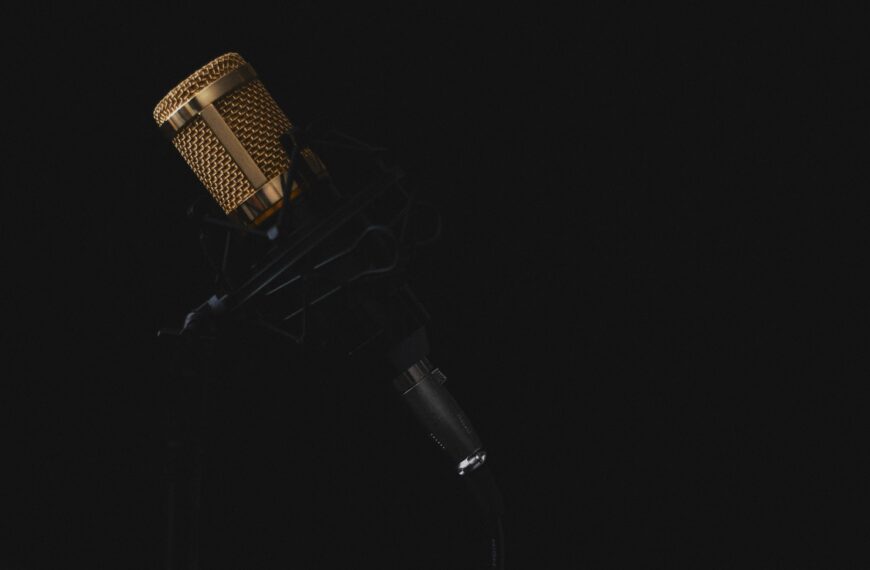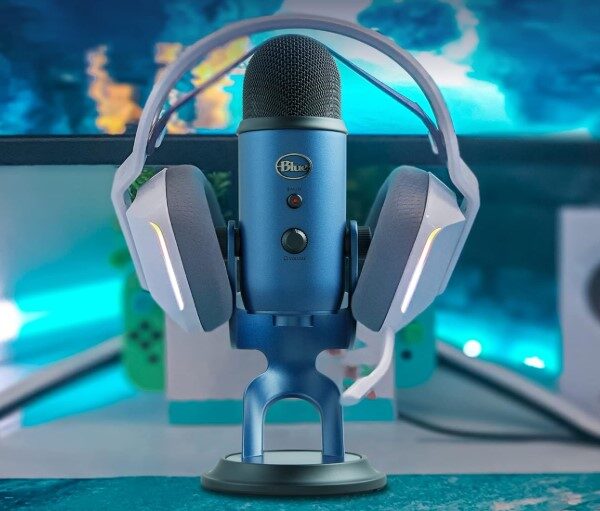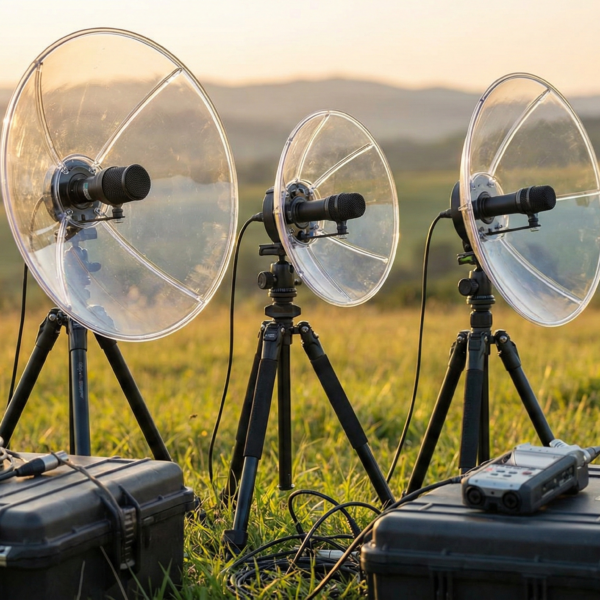Most of us assume that the best microphones are the most expensive ones, but that’s far from the truth. Many top-rated podcasts and even famous albums have been recorded using budget-friendly microphones—proving that technique and mic choice matter more than price. You just don’t have any idea about Different Types of Microphones
For instance, the Shure SM57, a mic that costs around $100, has been used in legendary music recordings by artists like The Rolling Stones and U2.
Similarly, many successful podcasters started out with affordable mics like the Audio-Technica ATR2100x or Samson Q2U, both under $100, before upgrading. 🎙️
What really makes or breaks your audio quality isn’t the price tag but whether you’re choosing the right type of microphone for your needs.
The world of microphones can be overwhelming, with terms like dynamic vs. condenser, cardioid vs. omnidirectional, and XLR vs. USB—and trust me, I’ve been down that rabbit hole.
I once bought a $300 condenser mic, thinking it would instantly make my podcast sound studio-quality, only to realize it picked up every tiny background noise—including my neighbor’s dog barking three houses away. 🤦♂️
Turns out,
I needed a dynamic mic instead.
So, how do you know which mic is right for you?
No worries!
In this blog,
we’ll break down different types of microphones, their strengths and weaknesses, and help you pick the perfect match for your setup. 🚀
- Primary Microphone Types
- Polar Pattern in Microphones
- How to Choose the Perfect Microphone
- Final Thoughts
- Related Posts
Primary Microphone Types
Microphones are of various shapes, sizes, and functionalities, designed for specific recording purposes and stuffs.
Before talking about the specifics of each microphone type, lets get the basics.
Dynamic Microphones
First up, we have the mic that’s probably the most recognized by you guys, and it is called the Dynamic microphones.
These are rugged and durable microphones that are great for live shows and record loud sound sources like drums and electrical guitar amplifiers.

Dynamic microphones operate using electromagnetic induction, where a coil moves within a magnetic field to convert sound waves into electrical signals.
Because they are passive, they don’t need an external power source like condenser microphones do.
This makes them incredibly reliable and durable, a reason why they’ve been a staple for live performances, broadcasting, and even podcasting for decades.
In fact,
the legendary Shure SM58, a dynamic mic, has been known to survive extreme conditions—my friend Aaron has even claimed that their SM58 still worked after being dropped from a two-story building! 🎤😲
One of the biggest advantages of dynamic microphones is their ability to reject background noise exceptionally well.
Unlike condensers, which capture every tiny detail, dynamics focus more on the direct sound source while minimizing unwanted ambient sounds.
However, they do come with some trade-offs.
Compared to condenser microphones, dynamic mics have lower sensitivity and a limited frequency response—meaning they might not capture the ultra-fine details in high frequencies as well.
But this is actually an advantage in many cases, as it reduces the capture of unwanted hisses, pops, and ambient noises that could degrade the recording quality.
Interestingly, research has shown that dynamic microphones tend to be favored in live sound reinforcement because of their rugged build and feedback resistance (Audio-Technica, 2021).
Plus,
a 2022 industry survey found that over 80% of professional vocalists prefer using dynamic microphones for live performances due to their warm, natural sound and durability (SoundGuys, 2022).
That said, if you’re recording delicate vocals or intricate acoustic instruments, you might want to explore a condenser mic instead.
Check out the list of Best Dynamic Microphones and know more in detail.
Pros and Cons of Dynamic Microphones
Dynamic mics have a number of benefits.
In addition to being robust and able to withstand high sound pressure levels, they are also reasonably priced.
They can be used for a variety of purposes due to their adaptability, including broadcasting, podcasting, and voices and instruments.
On the other hand, in comparison to other kinds, dynamic microphones typically have a lesser sensitivity.
This implies that in order to attain ideal signal levels, they might need to use higher gain from the mixer or audio interface.
Furthermore, in comparison to condenser microphones, dynamic microphones typically have a marginally narrower frequency response.
Who Should Choose Dynamic Microphones?
A dynamic microphone is your best bet If you’re a musician who frequently performs live or records loud instruments such as drums or electric guitars.
Since it is durable and able to handle high sound pressure levels it’s a go-to choice for live sound reinforcement and recording.
Condenser Microphones
Next up, we have the condenser mics.
These are a little more sensitive, more precise.
You guys will see these in a lot of people’s home studio setups. Unlike the dynamic microphone, condenser mics are active, so they need to be powered by External or Phantom power through USB or through an XLR cable into an audio interface or preamp.

Condenser microphones are the go-to choice when you need sensitivity, precision, and clarity—far surpassing dynamic microphones in capturing fine details.
Unlike dynamics, which are built for durability and noise rejection, condensers specialize in picking up even the subtlest sounds, making them ideal for studio recordings, ASMR, and high-fidelity vocals. 🎙️
However, there’s a catch—they require external power, either +48V phantom power (if you’re using XLR) or direct power through USB.
This added requirement can be a bit inconvenient, especially for beginners who just want a plug-and-play solution.
I remember the first time I tried using a Neumann TLM 102—I plugged it straight into my audio interface, only to realize I had forgotten to turn on phantom power.
Rookie mistake! 😅
One reason professionals swear by condensers is their ability to capture a wide frequency range with incredible accuracy.
Studio legends like the AKG C414 and Neumann U87 have been industry favorites for decades because they offer pristine sound with almost no coloration.
According to a 2023 audio engineer survey, over 85% of top recording studios use condensers as their primary vocal microphones (SoundOnSound, 2023).
That being said, condenser mics aren’t perfect.
Their high sensitivity means they pick up everything—including background noise, room reflections, and even the faint hum of your computer fan if you’re not careful.
I once tried recording vocals in my untreated room, only to realize later that my condenser mic had picked up my neighbor’s dog barking in the distance!
This is why a controlled recording environment (or at least a well-placed pop filter and soundproofing) is crucial.
Pros and Cons of Condenser Microphones
There are many benefits associated with condenser mics for professional audio applications.
They are perfect for recording studio sessions, singers, and acoustic instruments because of their wide frequency range capture capability and precise sound reproduction.
They are also often quite handleable and lightweight, making them easy to move.
Condenser mics have this Drawback of usually being more brittle than Dynamic microphones and requiring an external power source.
This power,
sometimes called “phantom power,” is typically provided via a mixer or audio interface.
Condenser mics can also be more Susceptible to loud sources, which is why it’s important to adjust the gain properly if you want to prevent distortion.
Who Should Choose Condenser Microphones?
A condenser microphone is the way to go If you’re a vocalist, acoustic musician, or content creator and you want to capture crisp and detailed audio.
It is sensible and captures sounds and this quality just makes it an essential tool for studio recording and podcasting.
Large Diaphragm Condenser
Due to their larger surface area Large diaphragm microphones can record sound waves.
As a result,
they respond to a wider range of the emitting sources’ frequency spectrum.
Since they are able to detect more elements than other models, they are the industry standard for vocal recording.
It might be advisable to use a pop filter.
One reason to place a pop filter in front of the capsule is that it will assist reduce plosives, or puffs that occur when air enters the capsule and cause low frequencies.
However, there is another issue as well: over time, breathing in moisture can cause a capsule to become ruined.
Another quick tip if you’re recording vocals, this is nothing to do with the microphone really, but if you stick the microphone a little bit higher than the singer, they’ll tilt their head up and they might actually project more.
So that’s just something to know.
Talking about the most famous large diaphragm condensers, they are the Neumann series, the U47, U67, U87, the Manley Reference Mic, the AKG C414.
There’s those Weird-shaped blue microphones a lot of people use. There’s tons of, and most of them sound great.
If you’re on a budget, there’s a microphone called the Rode NT1 that a lot of people like to get.
The first large diaphragm connector my friend got was this Audio-Technica 4040, which I would still recommend.
It’s great. And this mic that I’m holding here is kind of a more boutique microphone.
It’s made by a dude or a company, I guess, Charter Oak in Texas.
The Charter Oak SA538, and I really love this microphone.
So if you wanna, you’re in the market, I could recommend that one.
Small Diaphragm Condenser
Positioning small diaphragm microphones is simple.
Their large dynamic range makes them perfect for recording a variety of instruments.
These are the tiny, cylindrical microphones that you frequently see on stage or in recording studios.
The remarkable transient response of small diaphragm microphones is one of their main advantages.
These microphones are excellent at capturing sudden variations in sound strength because of the smaller diaphragm mass.
As a result,
they are perfect for recording sharp-attacking instruments like string, percussion, and acoustic guitars.
A More Genuine and Detailed sound is produced by precisely capturing the subtleties and dynamics of the performance through the faithful reproduction of quick transients.
Here is a list of the Best Condenser Microphones under 100$. Go check em out!!
Ribbon Microphones
Ribbon microphones are renowned for their warm, authentic sound reproduction and have a long history.
To detect sound waves, they employ a thin metal ribbon hanging in a magnetic field.
Soft vocals and string instruments are two examples of delicate sounds that are especially well-suited for recording using ribbon microphones.

Their figure-eight design rejects noise from the sides and picks up noises from the front and back.
These microphones have a delicate structure, therefore care must be used when handling them, yet the sound quality can be excellent in both live and studio environments.
Ribbon microphones are often used for recording vocals, strings, brass, and woodwinds.
Ribbon mics are probably the most natural-sounding mics.
They are so beautiful; they add ambience to your sound, and the natural high-frequency roll-off cuts off a lot of the harsh tones like dynamic microphones.
Most ribbon microphones are passive, meaning they don’t require an external phantom power supply.
Ribbon microphones use a thin metal diaphragm, usually made of aluminum.
This ribbon changes the magnetic field created by a ribbon coil to produce electrical signals as it vibrates in response to sound waves.
Their unique tone is enhanced by the ribbon’s delicate texture and their retro style.
Ribbon microphones are great for recording vocals, strings, and other acoustic instruments because of their ability to capture subtle details.
Their natural, smooth sound reproduction with soft roll-offs in the high frequencies adds to their vintage appeal.
Pros and Cons of Ribbon Microphones
Ribbon microphones are advantageous in a number of ways for particular uses.
Audio professionals are drawn to them because of their precise portrayal of timbre and great transient response.
Additionally, ribbon microphones are particularly good at capturing the organic feel of a space, giving recordings a feeling of depth and space.
However, compared to dynamic and condenser microphones, ribbon microphones are typically more brittle.
The ribbon element is sensitive and readily damaged by mechanical trauma or high wind pressure.
Furthermore,
a preamp with enough gain to obtain appropriate signal levels could be needed due to their low output levels.
Who Should Choose Ribbon Microphones?
If you’re chasing a vintage feel and aiming for rich, ambient recordings, a ribbon microphone is an excellent.
Its ability to add depth and warmth to recordings makes it a favorite among musicians and audio engineers seeking a classic sound.
Shotgun Microphones
The music industry does not employ shotgun microphones.
They are sometimes known as canon mics.
Their expertise lies in mitigating off-axis noises, and they ensure extremely accurate recording.
The directivity of these tube-shaped microphones is higher.
They mostly work in the film and television industries.

We will be able to choose the best microphone for our projects as we investigate the intricacies of each kind.
It’s important to consider the environment and the source of sound while choosing the appropriate microphone.
With this realization, we can make better decisions and record audio of much higher quality.
There is a microphone out there that can handle the demands of your creative efforts, be it podcasting, music production, or filming.
Who Should Choose Shotgun Microphones?
Shotgun microphones are good in picking up audio from a distance, thanks to their highly directional super-cardioid pattern.
I prefer them for you if you are working in movies industry and television shows because it is crucial to record dialogue clearly without interfering with the action.
The narrow pickup pattern reduces side and rear noise while aiding in sound source isolation.
These microphones are a vital tool for filmmakers and videographers who need concentrated audio in noisy or outdoor settings.
They are usually mounted on booms or stands.
Lavalier Microphones
Lapel mics, also known as lavalier microphones, are tiny, covert microphones that are frequently used in theater, public speaking, and television.
They are hands-free and simple to attach to clothing, which makes them ideal for presentations and interviews.

Excellent lavalier microphones can be wirelessly connected for increased mobility and capture sound with exceptional fidelity despite their small size.
Their inconspicuousness and ease of use outweigh any potential ambient noise they may pick up over larger microphones.
Lavalier microphones are omnidirectional, meaning they can pick up sound coming from any angle.
The transducer and diaphragm are usually housed in a tiny capsule.
The microphone is coupled to a bodypack transmitter or a wireless system, giving freedom of movement for the wearer.
These mics are frequently utilized in situations where portability and convenience are crucial, such as live performances, video production, and interviews.
They are excellent for recording conversations and other spoken words, making sure that the audio is understandable even when the speaker is moving.
Here is a list of the Best Lavalier Microphones. Go check em out!!
Pros and Cons of Using Lavalier Microphones
Lavalier microphones have a lot of benefits, especially when a hands-free option is needed. When fastened to garments, their small size and understated design make them almost unnoticeable.
They give artists and presenters the freedom to roam about without being constrained by wires thanks to their wireless connectivity.
However, because of their near proximity to the wearer, lavalier microphones may be more sensitive to handling noise and rustle in garments.
Due to their omnidirectional polar pattern, they are also limited in their ability to record ambient and atmospheric sounds.
However, lapel mics can produce excellent audio in a variety of applications when utilized properly.
Who Should Choose Lavalier Microphone?
Lavalier microphones can be good for anyone who needs a discreet and hands-free audio solution.
They are particularly popular among presenters, interviewers, and vloggers who require mobility while speaking.
Filmmakers often use lavalier mics to capture dialogue to ensure clear sound in crowded environments.
These mics are also perfect for educators and public speakers.
Overall,
if you value freedom of movement and need to capture clear audio, a lavalier microphone can be a choice.
Polar Pattern in Microphones
In addition to microphone types, there are polar patterns, which make sure how microphones pick up sound from different directions.
Common polar patterns include cardioid, omnidirectional, and figure-of-eight.
- Polar patterns will determine the microphone’s sensitivity from different directions.
- Common types include cardioid, omnidirectional, and figure-of-eight patterns.
Cardioid Polar Pattern
Cardioid microphones are most sensitive to sound coming from the front and reject sound from the sides and rear.
They are ideal for capturing vocals and solo instruments while minimizing background noise.
Cardioid Polar Pattern:
- Heart-shaped pickup pattern.
- Most sensitive to sound from the front and rejects sound from the sides and rear.
- Ideal for vocals and solo instruments, focusing on a single sound source and rejecting background noise.
- Suitable for environments with noise and reverberation.
Who Should Choose Cardioid Microphones?
A cardioid microphone can be the last thing you’ll need If recording vocals or solo instruments in noisy or untreated rooms.
Its directional sensitivity will ensure that only the intended sound source is captured, which is why for studio recording and live performances it is perfect.
Omnidirectional Polar Pattern
Sound from all 360 degrees surrounding the microphone is captured by an omnidirectional microphone.
Regardless of the microphone’s and the source’s positions, any sound source is recorded and subsequently replayed.
For example, it can be used to capture the resonance of a musical instrument and the room’s reverberation.
Omnidirectional Polar Pattern:
- They will Capture sound waves from all directions equally.
- Good choice for recording groups of people and ambient sounds.
- They are good in acoustically treated environments where natural recordings are desired.
Who Should Choose Omnidirectional Microphones?
When recording interviews podcasts or any other type of podcast, or natural ambient sounds, an omnidirectional microphone can be the thing you want.
Its ability to capture sound from all directions will ensure better recording experience.
How to Choose the Perfect Microphone
Since we’ve explored the different types of microphones and polar patterns let’s discuss how to choose the perfect microphone for your recording needs.
When selecting a microphone, consider the following factors:

1. Type of Instrument or Sound Source: Find out what you’ll be recording, is it vocals, instruments, or ambient sounds.
2. Recording Environment: Consider if you’ll be recording in a studio or live setting and the level of ambient noise present.
3. Desired Sound: Figure out the type of sound you want to achieve, if it’s warm and natural or crisp and detailed.
Putting It All Together
Once you’ve answered these questions, you can now think about your microphone choices. For example:
- A dynamic microphone is the way to go If you’re recording a guitar amplifier at a live performance, since it is durable and its ability to handle loud sound sources.
- A condenser microphone is the perfect choice If you’re recording vocals in a studio and want to capture crisp, detailed audio, for its sensitivity and wide frequency range.
- A ribbon microphone will add warmth and depth to your recordings, If you’re aiming for a vintage sound and recording vocals or acoustic instruments.
Final Thoughts
In conclusion, If you understand the different types of microphones and polar patterns and considering factors such as instrument type, recording environment, and desired sound, you can select the ideal microphone for your needs.
Remember, when it comes to microphones, there is no one-size-fits-all answer. Try out a variety of microphones, listen to your instincts, and choose the one that best suits your recording style and needs. Have fun with your recordings!
Into Podcasting? Podcasting is a different game, and without a precise blueprint, the game will get tougher in the midway. Grow your podcast from scratch with Zero Audience and learn about how successful podcasters cracked the code by winning our Free Guide with step by step Guidelines.
Get your equipment and setups by visiting Podcast Equipment Bundle. Know more about podcasting services that will help you save time at Podcast Production Services.
With that being said, Let’s connect with all such free and paid tool/services you might need knowingly or unknowingly to fuel your growth. Here’s 21 BEST AI TOOLS AND PLATFORMS TO GROW YOUR PODCAST AND CONTENTS. There are some bonus tools in the end too to make your day to day life easier.
There are some affiliate links on this page that will redirect you directly to the original products and services. Also by buying through those links you will be supporting us. So thank you ^.^
Related Posts
- Best USB Microphone Models Under $150
- Best Microphone Under $100
- Best Dynamic Microphone for podcasting
- Best USB Mic for beginners – Blue Yeti USB Microphone vs Fifine XLR USB Dynamic Microphone
- Dynamic vs Condenser Mic
- Best Under $100 Condenser Mic
- Best of the Most Expensive Microphones to Buy
- Best Wireless Mics
- Different Types of Microphones and Their Features



